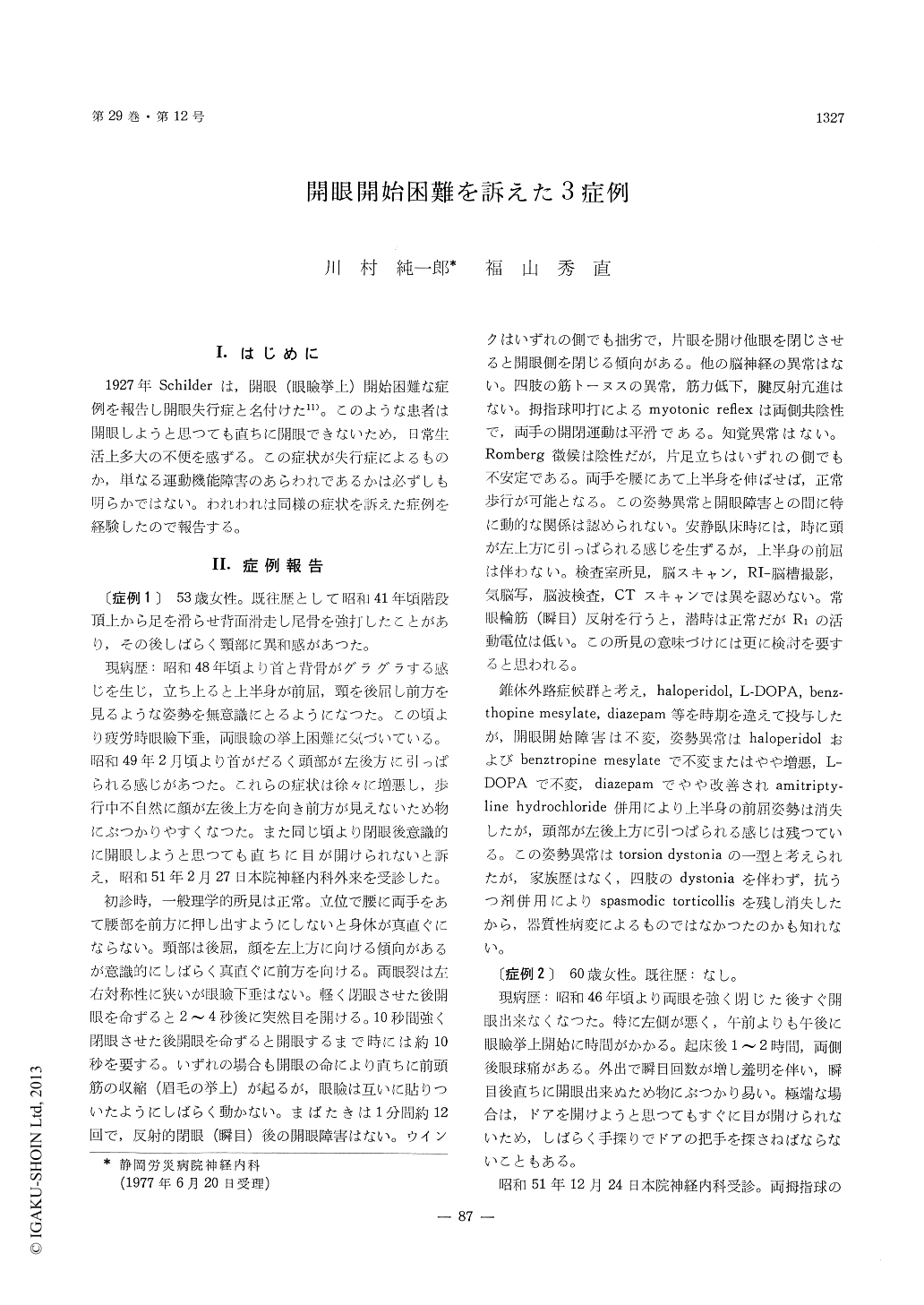Japanese
English
- 有料閲覧
- Abstract 文献概要
- 1ページ目 Look Inside
I.はじめに
1927年Schilderは,開眼(眼瞼挙上)開始困難な症例を報告し開眼失行症と名付けた11)。このような患者は開眼しようと思つても直ちに開限できないため,日常生活上多大の不便を感ずる。この症状が失行症によるものか,単なる運動機能障害のあらわれであるかは必ずしも明らかではない。われわれは同様の症状を訴えた症例を経験したので報告する。
Since 1927 when Schilder first described "apraxia of lid opening" cases have been reported under the same term but with different neurological com-plications. This report deals with a case of this category and 2 cases of blepharospasm. The latter presented also with difficulty in opening eyelids even after reflex blinking.
The first case was a 53 year old woman with spasmodic torticollis which gradually appeared in 1971. In the subsequent years she noted in difficultyto open her eyes only when she wanted to do so. She was seen at our out-patient clinic on 2/27/'76, at which time she was unable to stand straight without holding her waist with both hands to push it forward. The head tended to be turned to the left and up, which could be easily corrected volun-tarily. She blinked 12 times per minute, but on command the patient first tried to open her eyes with the elevation of eye brows, and in the next 4 to 10 seconds the eye lids suddenly popped open. Her spasmodic torticollis improved with adminis-tration of diazepam and amitriptyline hydrochloride, but the difficulty in voluntary lid opening remained unchanged even with other medications such as haloperidol, L?DOPA and benztropine mesylate among others. This case appeared to have either "apraxia" or supranuclear disorder of voluntary lid opening.
In contrast other 2 cases suffered from blepharo-spasm. In both blink rates were 40 to 50 per minute. On examination both took approximately 2 seconds to open their eyes on command. The second case in particular had very much trouble in her every day life. She bumped into objects while walking and had to grope for a door knob to open a door on many occasions, because her eyes would not open at an appropriate time. This 60 year old woman had pains in both eyes referrable to corneal erosion. Eye drops helped her very much with improvement of both ocular pains and difficulty in opening eyes. The third case, a 53 year old man, showed no ophthalmological abnormalies. Both eye drops and other medications had little effects on him.
Apraxia in general has been considered a dis-connection syndrome, particularly involving the corpus callosum. While the pyramidal tract is involved in movements of extremities, axial movements are mediated primarily by non-pyramidal system. Lesions producing apraxia would affect either one of these systems or both. Clinically the occasional association of "apraxia of lid opening" with extrapyramidal symptoms appears to indicate supranuclear disorder in initiation of voluntary lid opening. It is, however, still controversial whether the impaired voluntary lid opening is a kind of apraxia or akinesia. Furthermcre a recent report postulate that it might indicate "pseudomes-encephalic palsy". It is not easy to draw any conclusion on this matter withous further studies.

Copyright © 1977, Igaku-Shoin Ltd. All rights reserved.


